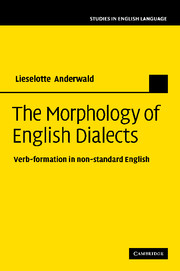Book contents
- Frontmatter
- Contents
- List of figures
- List of maps
- List of tables
- Preface and thanks
- Acknowledgement of sources
- 1 Introduction
- 2 Past tense theories
- 3 Naturalness and the English past tense system
- 4 Sellt and knowed: non-standard weak verbs
- 5 Drunk, seen, done and eat: two-part paradigms instead of three-part paradigms
- 6 Come and run: non-standard strong verbs with a one-part paradigm
- 7 Conclusion: supralocalization and morphological theories
- Appendix 1 Verb classification
- Appendix 2 SED localities and list of counties
- Bibliography
- Index
1 - Introduction
Published online by Cambridge University Press: 30 July 2009
- Frontmatter
- Contents
- List of figures
- List of maps
- List of tables
- Preface and thanks
- Acknowledgement of sources
- 1 Introduction
- 2 Past tense theories
- 3 Naturalness and the English past tense system
- 4 Sellt and knowed: non-standard weak verbs
- 5 Drunk, seen, done and eat: two-part paradigms instead of three-part paradigms
- 6 Come and run: non-standard strong verbs with a one-part paradigm
- 7 Conclusion: supralocalization and morphological theories
- Appendix 1 Verb classification
- Appendix 2 SED localities and list of counties
- Bibliography
- Index
Summary
But it was in the verbal conjugation that the Ablaut found its peculiar home, and there it took formal and methodical possession.
(Earle 1892: §124)The past tense — a descriptive approach
PAST is the most frequently marked verbal category by far (e.g. according to Sampson 2002, based on figures from the British National Corpus), accounting for around 25 per cent of all verb forms in contemporary spoken British English. In comparison, the two next categories, negation or modals, both only account for roughly 12 per cent of verb forms, the perfect for around 8 per cent, and the progressive for under 6 per cent. The passive finally is at best marginal with a text probability of under 1 per cent.
Past tense formation in English appears to be a very simple matter. Nevertheless — or perhaps because of this simplicity — great theoretical significance has been attached to an analysis of the past tense because it is used as the prime example in a long-standing debate in morphological theory (more on which in Chapter 2).
Putting it in simple descriptive terms (although no description is of course theory-free, or truly pre-theoretical), the majority of English verbs today have past tense forms that consist of the present tense stem plus <-ed>.
- Type
- Chapter
- Information
- The Morphology of English DialectsVerb-Formation in Non-standard English, pp. 1 - 16Publisher: Cambridge University PressPrint publication year: 2009

